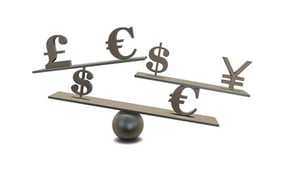This is the time of year when many organizations are coming down the home stretch and working  diligently to optimize their financial performance for the 4th quarter and the end-of-year. After the “close”, leaders will share with their investors and employees the “final” financials sometime during January. The big indicators of success include revenue, revenue growth, profit, margin growth, cost reductions, and cash positions. And all of that is good…
diligently to optimize their financial performance for the 4th quarter and the end-of-year. After the “close”, leaders will share with their investors and employees the “final” financials sometime during January. The big indicators of success include revenue, revenue growth, profit, margin growth, cost reductions, and cash positions. And all of that is good…
Until it isn’t.
One of the ways it isn’t is when currency fluctuations impact the business and financial performance. Imagine for a moment that ABC Manufacturing is forecasting $500,000,000 in profit for the 4th quarter with most of it being driven by sales in Asia. Suddenly, there is a currency fluctuation and that $500,000,000 of forecasted profit is now only worth $487,000,000 because the value of the currency. In the blink of an eye, the company “lost” $13,000,000! But where did it go? Did it go to a different line item? Did it just disappear? Who’s accountable for this miss?
The answers and what to do about currency fluctuations is becoming more and more of an important advanced business acumen concept. Let me take a moment to share a definition and then several insights and skills that can be utilized to be more aware and proactive.
Defining Currency Fluctuations
The current global economy is based on a floating exchange rate system and currency fluctuations are the direct result of this system. Our floating exchange rate system is set by the foreign exchange markets and is based almost entirely on the supply and demand of currencies. It is a natural ebb and flow unlike a fixed system where a government sets the rate and that’s it. In addition to the supply and demand of the actual currencies, the exchange rate of one currency against others is also influenced by economic performance, inflation, interest rates, the flow of capital into the economy, employment, population growth, geopolitical issues, and other core economic elements. Because all these elements are in a state of constant flux, global currencies are also in a state of constant flux.
What Should Leaders Do?
I am currently working on a new Business Acumen module and tailoring our core Advantexe Global Enterprise Business Simulation (AGES) to meet the needs of our clients in terms of currency fluctuations. Here are 3 things we are going to focus on:
Integrate F/X into Your Business World
If you are in business, then currency fluctuations impact you. If you don’t pay any attention to them, you need to. There are several great websites that provide instant updates and deep analysis of what’s happening. The sites listed below have clean interfaces and provide unique insights for free. They all have paid services but most of you will not need anything more than the basic information”
Know Your Business and Strategy
If you are a US-based company exporting goods or services internationally, you are going to be happier when the dollar is weaker (making the exchange rate higher). This way, if you get paid in other currencies like the Euro, you will have more dollars in the bank. Unfortunately, when the dollar is strong (making the exchange rate lower), you are going to have less dollars in the bank. If your business strategy is to import and sell products, then you are unhappy when the dollar is weak because you are getting less value and happy when the dollar is strong as you are getting more value. Now, this is where is can get a little complicated with the inclusion of “hedging” into the conversation. Basically, hedging is like paying insurance that keeps things steady so you don’t lose too much value or gain to much value from the currency fluctuations.
Be More Proactive with Timing of Foreign Orders
If you know that you have a need and purchase raw materials or other finished goods from outside of the United States for use in your products, then there are opportunities to follow trends and think more strategically about the timing. For example, if you conduct a basic trend analysis and determine there are classic patterns of currency fluctuations due to seasonality, weather, or other conditions, then depending on the business and strategy, you could shift your approach and lock in purchases for a lower overall cost.



